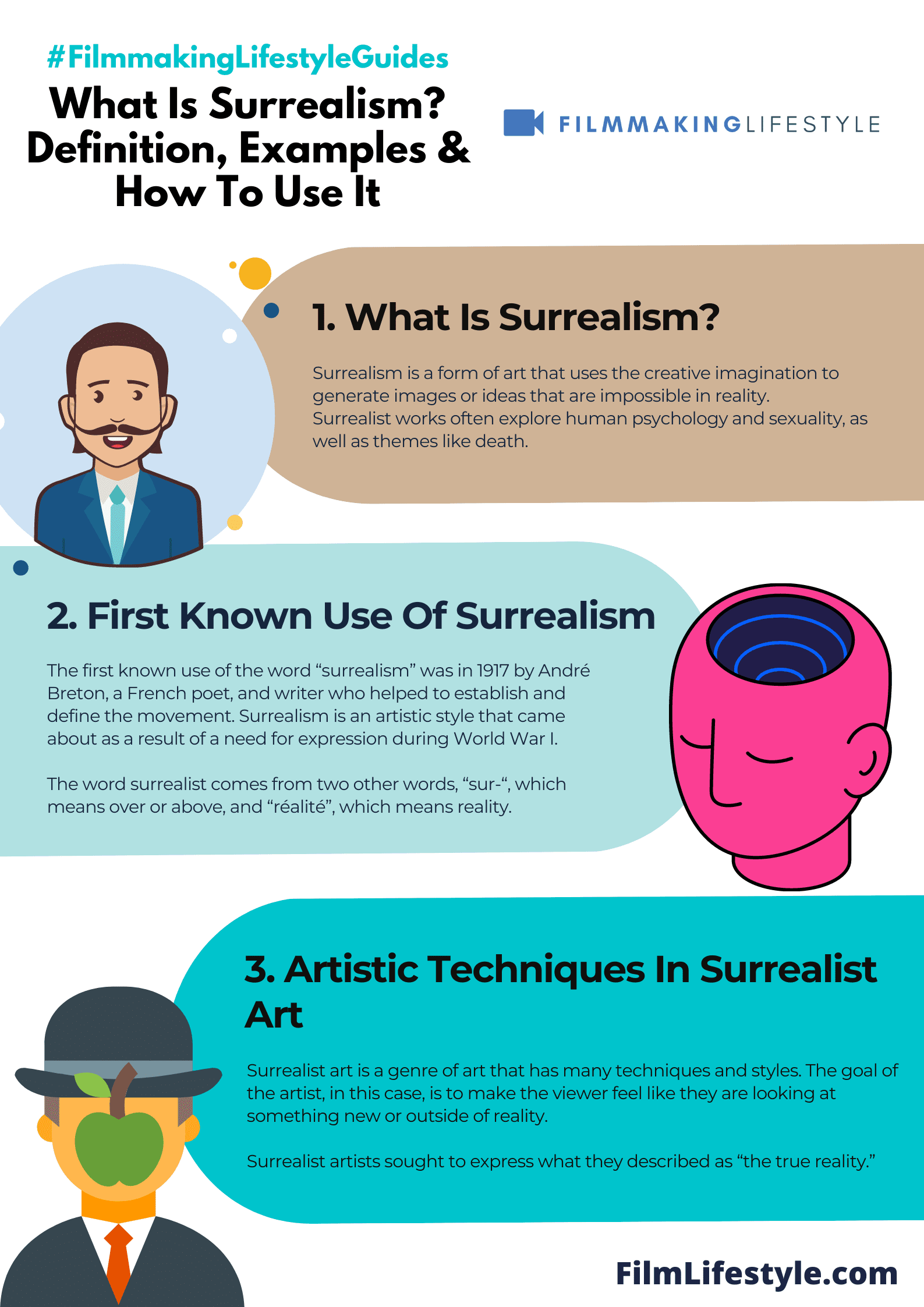Surrealism is a French art movement that began in the early 1920s and continued throughout the twentieth century.
Surrealism is the practice of using techniques such as juxtaposition, non-sequiturs, irrational juxtapositions, and disturbances in a way that evokes an emotional reaction from its audience.
Surrealist art often has no coherent meaning but can be seen as a creative outlet for exploring themes like dreams, desires, and the subconscious.
WHAT IS SURREALISM
What Is Surrealism?
Surrealism is a form of art that uses the creative imagination to generate images or ideas that are impossible in reality.
Surrealist works often explore human psychology and sexuality, as well as themes like death.
The word surreal comes from the French word surréaliste, which means “overly real.”
Surrealism’s a cultural movement that’s as intriguing as it is difficult to pin down.
It’s a world where the bizarre meets the beautiful, where artists and writers defy the conventional to explore the unconscious mind.
We’ll uncover the origins of surrealism, its key figures, and its impact on art and literature.
Get ready to step into a realm where dreams and reality collide, and nothing’s quite what it seems.
Origins Of Surrealism
Surrealism emerged from the chaotic aftermath of World War I, blossoming as a cultural movement in the 1920s.
It was a revolt against the destruction and disillusionment of war, intending to liberate thought, language, and human experience from the oppressive boundaries of rationalism.
The movement’s philosophical roots can be traced back to a range of sources – including Dada, an anti-art movement that challenged conventional aesthetics and celebrated nonsense and irrationality.
Surrealism also drew heavily on the studies of Sigmund Freud, whose explorations of the unconscious mind proved pivotal.
In 1924, poet André Breton released the Manifesto of Surrealism, effectively coining the term and setting the stage for the movement’s development.
Breton’s work emphasized the importance of tapping into the subconscious to unleash creativity.
Surrealist artists and filmmakers, inspired by these ideas, began creating works that defied traditional forms and narrative structures.
Movies such as Un Chien Andalou and The Seashell and the Clergyman shattered preconceived notions of storytelling and pushed the boundaries of visual imagery.
We recognize key figures who shaped Surrealism’s trajectory:
- Salvador Dali, with his iconic melting clocks and dream-like landscapes,
- Man Ray, who explored the subconscious through photographic experiments,
- René Magritte, whose thought-provoking images blurred lines between reality and dreams.
These pioneers set the foundation for what would become one of the most transformative movements in art and film, enabling future generations to explore vast horizons of creative expression.
They taught us that reality, as seen through the Surrealist lens, can be much more pliable and multi-layered than we ever imagined.
Key Figures In Surrealism
Surrealism is synonymous with some of the most revolutionary minds in art and literature.
Salvador Dali is often the first name to surface when discussing surrealism, renowned for his striking and bizarre images.
André Breton, the author of the Manifesto of Surrealism, was the movement’s principal theorist and leader.
His work set the stage for a radical rethinking of artistic expression.
As we jump into surrealism in the realm of film, Luis Buñuel stands as a titanic figure.
He and Dali collaborated on the groundbreaking film Un Chien Andalou, which remains a pinnacle of surrealist cinema.
Max Ernst, with his diverse approaches – including painting, collage, and sculpture – demonstrated that surrealism transcends a single medium.
His inventive techniques like frottage exemplify surrealism’s experimental spirit.
Let’s not overlook René Magritte, whose thought-provoking works challenge perceptions of reality.
His famous image of a pipe, captioned “This is not a pipe,” invites viewers to question the link between language and imagery.
Man Ray brought surrealism to photography with his ethereal images and innovative darkroom techniques.
His “rayographs” showcased the unexpected beauty of random objects cast in new light, a hallmark approach within surrealist art.
The influence of these key figures in surrealism extends beyond their lifetime, shaping diverse creative fields:
- Art,
- Literature,
- Film.
Their legacy persists in contemporary works that challenge the audience’s sense of the ordinary.
Surrealist tropes are evident in modern films that blur the lines between dreams and reality, just as Dali and Buñuel did nearly a century ago.
Exploring The Unconscious Mind
The unconscious mind has always been a fundamental element in the exploration of surrealism.
It’s a vast, untapped source of imagery and ideas that artists and filmmakers have delved into for inspiration.
Surrealists believed that unlocking the unconscious could lead to a more profound and authentic form of creativity.
In film, this approach allowed for a visual language that transcended traditional narrative structures.
Salvador Dali and Luis Buñuel showcased this in the iconic film Un Chien Andalou.
The film’s disjointed scenes and bizarre, dream-like sequences challenge viewers to interpret imagery from a subconscious perspective.
Another notable example is The Persistence of Memory, one of Dali’s most famous paintings.
Its melting clocks and disjointed landscapes serve as a direct representation of dream imagery and the fluidity of time perceived through the unconscious mind.
We often find that surrealism in film involves:
- Scenes that defy logical interpretation,
- Juxtapositions that blur the line between dream and reality,
- Use of symbolic objects to represent complex ideas.
Surrealist films aim to provoke thought and evoke emotions through abstract and unconventional means.
They often forgo a linear plot, instead embracing a stream-of-conscious narrative mimicking the nonsensical nature of dreams.
Our fascination with surrealism extends to the way it influences modern filmmakers.
Today’s directors might draw upon these techniques for moments within their films, paying homage to the surrealist tradition while weaving it into contemporary storytelling.
It’s these elements that continue to inspire and challenge the industry.
The use of surrealist techniques creates an immersive experience for the audience, allowing us to question our own perceptions of reality.
Surrealism In Art
Surrealism has long transcended the canvas.
Melding the eerie depths of the unconscious mind with visual creativity, artists such as Max Ernst and René Magritte have pushed the boundaries of traditional aesthetics.
They imbued their artwork with a dream-like quality that frightens, mystifies, but above all, fascinates us.
We see this as a direct line to the core of surrealism – presenting the impossible as though it were entirely real.
The relationship between surrealism and filmmaking is particularly significant.
Surreal films, building on the work of ingenious artists, have a unique way of captivating audiences.
They transport us to a world where the mundane intersects with the fantastical, and nothing is quite what it seems.
Cinema like The Holy Mountain and Eraserhead stands as monuments of how powerfully surrealism can influence our experience of a story.
In witnessing the movement’s evolution, we recognize these key characteristics:
- Visual art relies on shock, unexpected contrasts, and strange creatures to question our sense of reality.
- Surreal cinema often evokes a visceral response – we’re equally intrigued and perturbed by what unfolds onscreen.
- The use of symbolism is essential – objects aren’t always what they appear to be, inviting us to look deeper.
Surreal art doesn’t just ask us to observe; it dares us to explore.
As we confront the scenes that straddle the line between the real and the imaginary, we’re driven to ponder the power of our own dreams and subconscious.
This exploration can be incredibly exhilarating, reminding us that beyond our waking life lies a profound world that we are only just beginning to understand through art.
Surrealism In Literature
Surreal literature often mirrors its visual art counterpart, draping narratives in an aura of dreamlike quality.
Just as in surreal films, books in this genre blend the everyday with the bizarre, creating a rich tapestry of symbolism and metaphor.
Authors like Franz Kafka and Andre Breton have pioneered the movement in texts.
Works like The Metamorphosis and Nadja demonstrate how literature can distort reality, urging readers to question their perceptions.
Surreal texts often feature:
- Disjointed timelines,
- Elements of surprise,
- Blurred lines between reality and dreams.
In these stories, characters may confront absurd or impossible situations.
This propels them – and us – to introspect on our understanding of the world around us.
The surrealist literary movement has been pivotal in influencing modern storytelling techniques.
It’s reshaped not just literature, but film narratives as well, introducing non-linear plot structures and dream sequences that challenge conventional storytelling.
We see the legacy of surrealism in contemporary literature too.
Books like The Wind-Up Bird Chronicle by Haruki Murakami inherit the surrealist mantle, weaving narratives that defy simple categorization.
By embracing surrealism, authors and filmmakers offer us new ways to see and interpret our own reality.
They remind us that appearing illogical or nonsensical can often reveal deeper truths about our existence.
What Is Surrealism – Wrap Up
Surrealism has undeniably carved a niche in the cultural fabric of our world.
It challenges us to see beyond the mundane and embrace a universe where dreams and reality intertwine.
As we’ve seen through the works of Kafka, Breton, and Murakami, this movement transcends time, influencing generations of storytellers.
It’s a testament to the power of the human imagination and its endless capacity to redefine the boundaries of our experience.
Surrealism isn’t just a historical footnote—it’s a living, breathing inspiration that continues to shape how we perceive and interact with the world around us.
Frequently Asked Questions
What Is Surrealism In Literature?
Surrealism in literature is a movement that combines the everyday with the bizarre, using symbolism and metaphor to challenge readers’ perceptions of reality.
It often includes disjointed timelines, surprising elements, and blurred boundaries between dreams and reality.
Who Were The Pioneers Of The Surrealist Movement In Literature?
Franz Kafka and Andre Breton were notable pioneers of the surrealist movement in literature.
How Does Surreal Literature Differ From Traditional Texts?
Surreal literature differs from traditional texts by distorting reality, using unconventional narrative structures, and incorporating elements of fantasy and surprise that defy conventional storytelling norms.
What Impact Has Surrealism Had On Modern Storytelling?

Surrealism has reshaped not only literature but also film narratives, influencing modern storytelling techniques with its unconventional approach and narrative structures.
Can You Give An Example Of Contemporary Literature That Follows The Surrealist Tradition?
The Wind-Up Bird Chronicle by Haruki Murakami is an example of contemporary literature that continues the surrealist tradition, offering new ways to explore and interpret reality.






